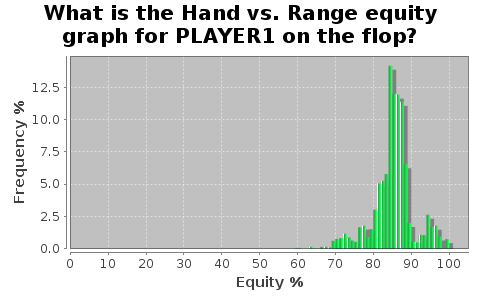
Observe from the graph that aces always have over 50% equity on any flop vs. an unknown random hand.
A glossary of some of the major concepts in the Odds Oracle (and PQL).
"All-in Equity" refers to the percentage of the pot each player stands to win on average. For "randomized" simulations, random hands (and boards for flop games) are dealt and river equity is tabulated. For "exhaustive" simulations, all possible combinations of hands and boards are created and exact results are generated.
PQL Functions: HvHEquity (aka equity), riverEquity, minEquity
"Equity" is a measure of what percentage of the pot is won by a given player. Generally speaking, "Equity" refers to hand vs. hand ("AsAk" vs "Jd2c") as opposed to range vs. range ("AA" vs "AK-JT") situations. "Equity" is an exact measure.
"riverEquity" is available for all games, and computes the equity once all cards have been dealt. "minEquity" and "HvHequity" compute exact hand vs. hand equity values before the last card is dealt - these functions are generally slower than "riverEquity"
PQL Functions: fractionalRiverEquity
An "equity fraction" is just a fractional representation of an exact equity value. For instance, "1/4" represents the same equity as "0.25" or "25%".
PQL functions: flopHandCategory, minFlopHandCategory, exactFlopHandCategory
Question: "How often does ... flop ..."
The Flop Hand Category provides specific information on what kinds of hands were hit by a particular player on the flop. (Contrast with Hand Type, which simply provides information about the best 5-card hand).
PQL Functions: fourFlush
A "four flush" occurs when a player has exactly four cards to a flush given the board cards.
PQL: "histogram(HvRequity(...))"
A "hand vs. range equity graph" shows a histogram of equities on a given street of play when one player is
dealt a hand from their range and all other players retain their range of hands. Put another way,
a single hand is dealt face-up and the other hands are face-down for each datapoint collected.
Here is the hand vs. range equity graph for aces vs. a random hand:
Observe from the graph that aces always have over 50% equity on any flop vs. an unknown random hand.
PQL: "histogram(HvHequity(...))"
A "hand vs. hand equity graph" shows a histogram of exact hand vs. hand equities on a given street of play.
Put another way, each datapoint of the graph shows the equity when all hands are turned face-up on the given
street. For instance, here is the equity graph for pocket aces vs. a random hand on the flop in hold'em:
Observe on the left side of the graph that aces can occasionally have very poor equity
(for instance, when the random hand flops a set), but usually aces are in very good shape.
Here is the same data viewed a different way. This shows how often aces achieve a certain minimum equity:
Note how much narrower the range of equities are in our Hand vs. Range graph compared to our Hand vs. Equity graph above. The reason for this is that in the Hand vs. Range case, the opponent's hand is unknown on the flop, and thus we generally don't know if we are crushed on the flop or not. In the Hand vs. Hand graph, all hands are face up, so if the flop comes 4s8dTc and our opponent has TsTd, we have very little equity.
A "hand" generally refers to an exact hand (as opposed to a range of hands). For example, "AsKs" is a hold'em hand, whereas "AA" is a range of hands.
Used in "Interactive Hand Stats for the Turn" in the Odds Oracle. Flop games only.
"Hand Category" as an extension of the idea of "Hand Type", but unlike "Hand Type" it is smarter about what actually hit our hand on the turn. Here are the different hand categories:
PQL Functions: handType, minHandType
"Hand type" is the type of poker hand made at a given point in the hand. For instance, in stud, the hand type for "As5s6s9sJs" on fifth street is "flush". For flop games, "hand type" does not distinguish between cards in the hand and cards on the board - as a result, the "Hand Type" for "KsJd" on a flop of "2s2h8d" is "pair", even though the pair is on the board. (See also 'Hand Category') The hand types are:
PQL Functions: inRange
A Range of Hands describes a set of possible hands for a given player. For instance, the range of hands "AA" describes six hands - "AsAh", "AsAd", "AsAc", "AhAd", "AhAc", "AdAc".
PQL Functions: loRating, hiRating, bestLoRating, bestHiRating
A lo or hi rating is a relative measure of the best 5-card hand that can be made for a given player on a given street. Note that a hand rating is only useful for comparison to other hand ratings. For example, if hiRating(p1, flop) > hiRating(p2, flop), then p1 flopped a stronger hand than p2.
PQL Functions: threeFlush
A "three flush" occurs when a player has exactly three cards to a flush given the board cards.
PQL Functions: winningHandType
The "winning hand type" is what 5-card hand type won the hand on the river. For instance, in stud where the final hands are "AsAhJdJs2s3d8c" and "KsQcJhTd9s5c5h", the "winning hand type" is "straight".